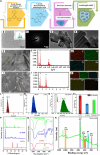Detection of Hg2+ Using a Dual-Mode Biosensing Probe Constructed Using Ratiometric Fluorescent Copper Nanoclusters@Zirconia Metal-Organic Framework/ N-Methyl Mesoporphyrin IX and Colorimetry G-Quadruplex/Hemin Peroxidase-Mimicking G-Quadruplex DNAzyme
- PMID: 39691776
- PMCID: PMC11650877
- DOI: 10.34133/bmef.0078
Detection of Hg2+ Using a Dual-Mode Biosensing Probe Constructed Using Ratiometric Fluorescent Copper Nanoclusters@Zirconia Metal-Organic Framework/ N-Methyl Mesoporphyrin IX and Colorimetry G-Quadruplex/Hemin Peroxidase-Mimicking G-Quadruplex DNAzyme
Abstract
Mercury (Hg2+) has been recognized as a global pollutant with a toxic, mobile, and persistent nature. It adversely affects the ecosystem and human health. Already developed biosensors for Hg2+ detection majorly suffer from poor sensitivity and specificity. Herein, a colorimetric/fluorimetric dual-mode sensing approach is designed for the quantitative detection of Hg2+. This novel sensing approach utilizes nanofluorophores, i.e., fluorescent copper nanoclusters-doped zirconia metal-organic framework (CuNCs@Zr-MOF) nanoconjugate (blue color) and N-methyl mesoporphyrin IX (NMM) (red color) in combination with peroxidase-mimicking G-quadruplex DNAzyme (PMDNAzyme). In the presence of Hg2+, dabcyl conjugated complementary DNA with T-T mismatches form the stable duplex with the CuNCs@Zr-MOF@G-quadruplex structure through T-Hg2+-T base pairing. It causes the quenching of fluorescence of CuNCs@Zr-MOF (463 nm) due to the Förster resonance energy transfer (FRET) system. Moreover, the G-quadruplex (G4) structure of the aptamer enhances the fluorescence emission of NMM (610 nm). Besides this, the peroxidase-like activity of G4/hemin DNAzyme offers the colorimetric detection of Hg2+. The formation of duplex with PMDNAzyme increases the catalytic activity. This novel biosensing probe quantitatively detected Hg2+ using both fluorimetry and colorimetry approaches with a low detection limit of 0.59 and 36.3 nM, respectively. It was also observed that the presence of interfering metal ions in case of real aqueous samples does not affect the performance of this novel biosensing probe. These findings confirm the considerable potential of the proposed biosensing probe to screen the concentration of Hg2+ in aquatic products.
Copyright © 2024 Shikha Jain et al.
Conflict of interest statement
Competing interests: The authors declare that they have no competing interests.
Figures







Similar articles
-
Development of a DNAzyme-based colorimetric biosensor assay for dual detection of Cd2+ and Hg2.Anal Bioanal Chem. 2021 Nov;413(28):7081-7091. doi: 10.1007/s00216-021-03677-x. Epub 2021 Sep 29. Anal Bioanal Chem. 2021. PMID: 34585255
-
Label-free and dual-mode biosensor for HPV DNA based on DNA/silver nanoclusters and G-quadruplex/hemin DNAzyme.Talanta. 2022 Sep 1;247:123554. doi: 10.1016/j.talanta.2022.123554. Epub 2022 May 18. Talanta. 2022. PMID: 35653859
-
A G-quadruplex-assisted target-responsive dual-mode aptasensor based on copper nanoclusters synthesized in situ in a DNA hydrogel for ultrasensitive detection of ochratoxin A.Talanta. 2024 Apr 1;270:125550. doi: 10.1016/j.talanta.2023.125550. Epub 2023 Dec 14. Talanta. 2024. PMID: 38104426
-
Amplified colorimetric detection of mercuric ions through autonomous assembly of G-quadruplex DNAzyme nanowires.Biosens Bioelectron. 2014 Feb 15;52:261-4. doi: 10.1016/j.bios.2013.08.034. Epub 2013 Sep 6. Biosens Bioelectron. 2014. PMID: 24060975
-
Colorimetric and Photocurrent-Polarity-Switching Photoelectrochemical Dual-Mode Sensing Platform for Highly Selective Detection of Mercury Ions Based on the Split G-Quadruplex-Hemin Complex.Anal Chem. 2022 Nov 1;94(43):15040-15047. doi: 10.1021/acs.analchem.2c03084. Epub 2022 Oct 19. Anal Chem. 2022. PMID: 36259408
Cited by
-
Direct Redox Sensing of Caffeine Utilizing Zinc-Doped Tin Oxide Nanoparticles as an Electrocatalyst.BME Front. 2025 Feb 19;6:0099. doi: 10.34133/bmef.0099. eCollection 2025. BME Front. 2025. PMID: 39974305 Free PMC article.
-
Application of CRISPR-Cas System in Human Papillomavirus Detection Using Biosensor Devices and Point-of-Care Technologies.BME Front. 2025 Mar 19;6:0114. doi: 10.34133/bmef.0114. eCollection 2025. BME Front. 2025. PMID: 40110345 Free PMC article. Review.
References
-
- Jiang G, Miao Y, Wang J, Shao H, Chen H, Tao P, Wang W, Yu Q, Peng W, Zhou X. Specific detection of mercury ions based on surface plasmon resonance sensor modified with 1, 6-hexanedithiol. Sensors Actuators A Phys. 2023;356: Article 114343.
-
- Fang Y, Zhang Y, Cao L, Yang J, Hu M, Pang Z, He J. Portable Hg2+ nanosensor with Ppt level sensitivity using nanozyme as the recognition unit, enrichment carrier, and signal amplifier. ACS Appl Mater Interfaces. 2020;12(10):11761–11768. - PubMed
-
- Erdemir E, Suna G, Liv L, Eğlence-Bakır S, Şahin M, Karakuş E. Smartphone-assisted dual-channel discriminative detection of Hg(II) and Cu(II) ions with a simple, unique, readily available probe. Sensors Actuators B Chem. 2023;382: Article 133487.
-
- Amaral CDB, Amais RS, Fialho LL, Schiavo D, Amorim T, Nogueira ARA, Rocha FRP, Nóbrega JA. A novel strategy to determine As, Cr, Hg and V in drinking water by ICP-MS/MS. Anal Methods. 2015;7(3):1215.
LinkOut - more resources
Full Text Sources

